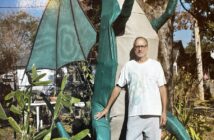By: Danielle Meikle
Nov. 2 marks a day of celebration in the Mexican culture. “Dia de Los Muertos,” or “The Day of the Dead,” is a special holiday that unites both the living and the dead. This year, the Spanish club gathered outside the Student Community Center to spread cultural awareness about this tradition to the students and staff of Saint Leo.
In the central and southern parts of Mexico, the Day of the Dead gives families a chance to honor their deceased relatives. It is not coincidental that the holiday coincides with the Catholic holidays “All Soul’s Day” and “All Saint’s Day,” which are days set aside to honor the dead and the Saints respectively.
According to Dr. Marcela Van Olphen, an associate professor of Spanish and Portuguese and the advisor of the Spanish club, “The holiday occurs because of the syncretism between the indigenous Aztec traditions and Spanish Catholic traditions.”
With the arrival of the Spaniards in central Mexico in the 16th century, this ritual of honoring the dead, which was practiced by the Aztecs starting some 3000 years ago, was suppressed because it was viewed as sacrilegious. However, the tradition did not disappear. Instead, it spread throughout Mexico and merged with some elements of Catholicism. The holiday, which was originally celebrated in the summer, was even moved to Nov. 1 and 2 to coincide with All Saints Days and All Souls Day.
The tradition is centered around the belief that on Oct. 31 at midnight, the gates of heaven are opened and the spirits of all deceased children, called “angelitos,” are allowed to reunite with their families for 24 hours. Then, on Nov. 2, the spirits of the adults can come down to enjoy the festivities that their loved ones have prepared for them. This stems from the belief that happy spirits will provide protection, good luck, and wisdom to their families.
“In Mexico, the students would pull pranks on the University President on this day,” chuckled Van Olphen. Instead, the Spanish club decided to commemorate Emiliano Zapata and Pancho Villa, a pair of Mexican revolutionaries that fought for social justice. The members set up an “ofrenda,” an altar with many items that were used to honor the spirits of these two men.
According to Van Olphen, “Families prepare an ofrenda with the favorite foods, items, and memorabilia of the deceased. They also use marigolds to make a cross and light candles, too. The soul of the deceased sees the light and is guided toward the altar.”
Building altars is a way to keep the family close, and it gives them a chance to reminisce on their loved ones.
Club members also served hot chocolate and bread, which represents a meal that would be served at the night time celebration in Mexico. This celebration would occur at the burial site of the deceased and features mariachi bands and card playing.
The students and staff were very appreciative of and impressed by this effort made by the Spanish club. Quite a number of people stopped by the table to sample the food and see the display.
“I have heard of this holiday before, but I never really knew what it was about, or how they celebrated it. I am happy that the Spanish club put up this display because I got a chance to learn more about Mexican culture, not to mention the hot chocolate which was delicious,” said Ashley Raghoo, a sophomore criminal justice major.




